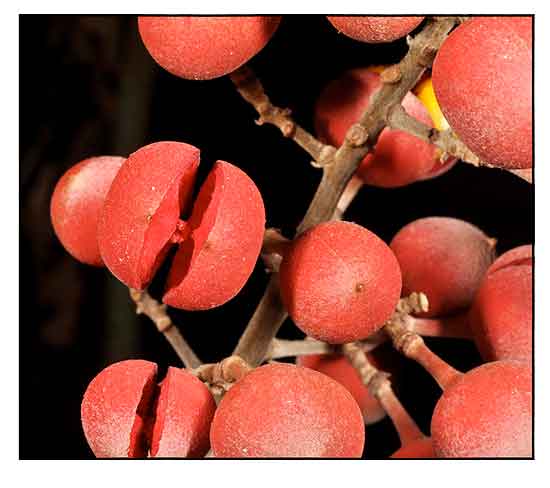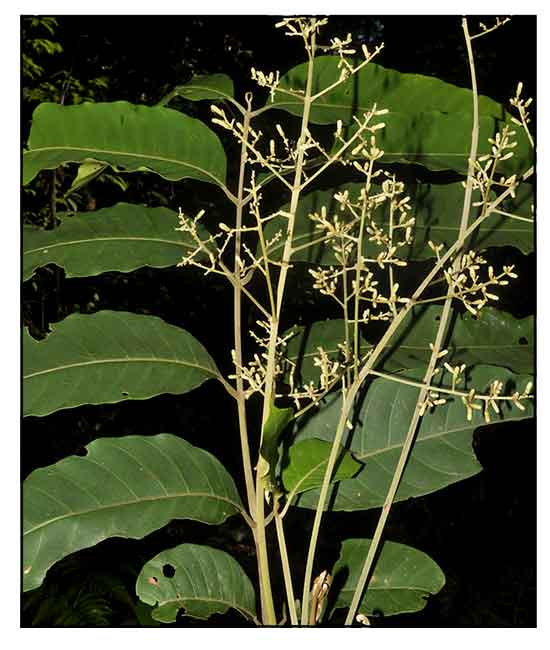 Gen info Gen info
- Chisocheton pentandrus is a tree in the family Meliaceae.
- Etymology: The genus name Chisocheton derives from Greek words schizos and chiton meaning "split tunic", referring to the lobed staminal tube of C. patens. (4) The specific epithet pentandrus derives from Greek meaning "five man", referring to the five stamens of each flower. (3)
Botany
• C. pentandrus is a small to medium-sized tree, up to 18(-40) m tall and 40 cm in diameter; bole branchless for up to 10 m, sometimes buttressed in the lowest 60 cm. Leaves alternate, up to 45 cm long, pinnate with up to 9 pairs of leaflets, pseudo-gemmulate; petiole 2-10 cm, petiolules 5-8 mm long; leaflets elliptical to ovate-oblong, up to 16(-26) cm × 6(-9) cm, veins 8-16 on each side of midrib. Inflorescence spiciform to thyrsoid, axillary or supra-axillary, up to about 60 cm long with fragrant, pedicellate flowers 8-18 mm long; calyx cupular, about 4 mm long; petals usually 5, valvate, 8-16 mm × 2 mm, cream, densely pubescent outside; staminal tube white, bearing 5 anthers; ovary 2-locular, shortly stipitate. Fruit a 2-seeded capsule, globose or beaked, up to 2 cm in diameter, dull red, minutely tomentose, pericarp containing white latex. Seed flattened globose, up to 15 mm in diameter, covered with a sarcotesta. (2)
Distribution
- Native to the Philippines.
- Also native to Borneo, Jawa, Lesser Sunda Is., Malaya, Maluku, Sulawesi, Sumatera, Thailand. (1)
 Constituents Constituents
- Study of stem bark isolated a new limonoid, pentandricine (1), along with three known limonoids, ceramicine B (2), 6-de(acetyloxy)-23-oxochisocheton (3), 6-de(acetyloxy)-23-oxo-7-O-deacetylchisocheton (4). (see study below) (4)
- Study of n-hexane extract of stem bark isolated 11 underscribed triterpenoids (pentandrucines A-K), ten underscribed dammarane-type triterpenoids and one underscribed apotirucallane-type triterpenoid, along with two dammarane-type triterpenoids, four apotirucallane-type triterpenoids and two tirucallane-type triterpenoids. (see study below) (5)
- A new aromadendrane-type sesquiterpenoid, dehydrosphatulenol, was isolated from the stembark of Chisocheton pentandrus.
(7)
- Study of stem bark isolated two flavanoid compounds, catechin (1) and epicatechin (2). (8)
- Study of n-hexane extract of stem bark isolated 8 cytotoxic constituents: six triterpenoids, cabralealactone (1), cabraleadiol (2), prototiamin A (3), 23-desmethyllimocin B (5), melianodiol (7), and indicalilacol (8), along with one limonoid, neemfruitin A (4) and one protolimonoid, protoxylocarpin G (6). (see study below) (9)
- Study of stembark isolated six limonoids, pentandricine (1), ceramicine B (2), 6-de(acetyloxy)-23- oxochisocheton (3), 6-de(acetyloxy)-23-oxo-7-O-deacetylchisocheton (4), dysobinin (5) and epoxyazadirone (6). (see study below) (10)
- Study of n-hexane extract of stem bark isolated three new limonooids namely pentandricines B-D (1-3), along with four known limonoids (4-7). (see study below) (12)
 Properties Properties
- Unlike other seed plants, the leaves of Chisocheton have indeterminate growth, meaning they never stop growing, instead, they form terminal leaflets with small leaf-tip bud, which produces new leaflets continuously. (3)
- Studies have suggested cytotoxicity, anticancer, antioxidant, antidiabetic, α-glucosidase inhibitory properties.
Parts used
Bark, kernel seed oil.
Uses
Edibility
- No reports found on fruit edibility.
Folkloric
- In the Philippines, kernel seed oil used as hair oil. (2)
- In Indonesia, bark used for treatment of jaundice. (2)
Others
- Wood: Timber used for light construction.
Studies
• Limonoids / Weak Cytotoxicity / Stem Bark: Study of stem bark isolated a new limonoid, pentandricine (1), along with three known limonoids, ceramicine B (2), 6-de(acetyloxy)-23-oxochisocheton (3), 6-de(acetyloxy)-23-oxo-7-O-deacetylchisocheton (4). The compounds showed weak or no cytotoxicity against MCF-7 breast cancer cells with IC50s of 369.84, 150.86, 208.93 and 120.09 µM, respectively. (4)
• Cytotoxic Triterpenoids / Melianodiol / MCF-7 Breast Cancer Cells / Stem Bark: Study of n-hexane extract of stem bark isolated 11 underscribed triterpenoids (pentandrucines A-K), along with two dammarane-type triterpenoids, four apotirucallane-type triterpenoids and two tirucallane-type triterpenoids. Of the compounds isolated, melianodiol proved to exhibited most cytotoxic activity against MNCF-7 breast cancer cells in vitro, with IC50 of 16.84, comparing favorably with cisplatin (13.2 µM). (5)
• Pentandricines / Cytotoxic Limonoids / Stem Bark: Study of stem bark isolated three new cedrelone-type limonoid derivatives, pentandricines F-H (1-3), along with four known limonoids (4-7). Compound 2, pentandricine G, was the most active compounds against MCF-7 breast cancer cells with IC50 of 48.11 µM, comparing favorably with cisplatin (53.32 µM). (6)
• Cytotoxic Constituents / Melianodiol / Stem Bark: Study of n-hexane extract of stem bark isolated 8 cytotoxic constituents: six triterpenoids, cabralealactone (1), cabraleadiol (2), prototiamin A (3), 23-desmethyllimocin B (5), melianodiol (7), and indicalilacol (8), along with one limonoid, neemfruitin A (4) and one protolimonoid, protoxylocarpin G (6). Of the isolated compounds, melianodiola (7) showed strongest cytotoxic activity against MCF-7 breast cancer lines in vitro with IC50 of 16.8 µM. (9)
• Limonoids / Epoxyazadirone / Anti-Breast Cancer Cytotoxicity / Stem Bark: Study of stembark isolated six limonoids, pentandricine (1), ceramicine B (2), 6-de(acetyloxy)-23- oxochisocheton (3), 6-de(acetyloxy)-23-oxo-7-O-deacetylchisocheton (4), dysobinin (5) and epoxyazadirone (6). Epoxyazadirone (6) showed strongest cytotoxic activity against MCF-7 breast cancer cells with IC50 of 9.12 µM. (10)
• α-Glucosidase Inhibitory / Antioxidant / Leaves: Study evaluated the antioxidant, antidiabetic, and antibacterial activity of C. pentandrus leaf extract. The methanol leaf extract showed highest antioxidant activity by DPPH-free radical assay, and highest inhibitory activity of the α-glucosidase enzyme. The extract showed no effect on inhibition of bacterial growth. (11)
• Limonoids / Nimonol / Cytotoxicity against MCF-7 Breast Cancer Cells
/ Stem Bark: Study of
n-hexane extract of stem bark isolated three new limonooids namely pentandricines B-D (1-3), along with four known limonoids (4-7). Compounds 1-7 were tested for cytotoxic activity against NCF-7 breast cancer cells in vitro. Compound 7, nimonol, showed strongest cytotoxicity activity with IC50 of 22.03 µM. (12)
Availability
Wild-crafted.
|

![]()




 Constituents
Constituents
